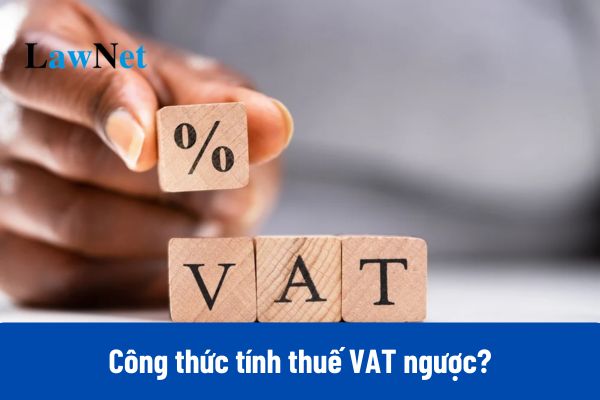What is the reverse VAT calculation formula in Vietnam for 2025? How many methods are there for VAT calculation in Vietnam?
What is the reverse VAT calculation formula in Vietnam for 2025?
Value Added Tax (VAT) is an indirect tax calculated on the added value of goods and services during production, circulation, and consumption according to Article 2 of the Value Added Tax Law 2008. When goods or services are sold, VAT is included in the sale price.
Forward VAT is the method of calculating VAT when the pre-tax value is known and the tax amount is to be added to the sale price (to obtain the post-tax price).
Reverse VAT, on the other hand, is applied when the sale price, including VAT, is known, and you need to calculate the original value of goods or services before VAT is applied. Generally, when consumers purchase goods, the price they pay already includes VAT. Therefore, if you want to know the original value (before VAT is applied), you need to use the reverse VAT calculation formula.
According to point k, clause 1, Article 7 of the Value Added Tax Law 2008, the reverse VAT calculation formula for 2025 is specifically provided as follows:
(1) Value Excluding VAT (Original Value)
| Price excluding value added tax = Payment price / (1 + Tax rate of goods, services) |
(2) VAT Amount Payable:
| Tax amount payable = Pre-tax amount (excluding VAT) x Tax rate |
Where:
+ Payment Price: This is the price that includes VAT. It is the amount you have paid for the product or service, including the value added tax. For example, you purchase a phone with a payment price of 1,100,000 VND (including 10% VAT).
+ VAT Rate: This is the percentage rate applied to the goods or service. Currently, there are 04 VAT rates: 0%, 5%, 8%, and 10%, applicable depending on the type of goods or services.
+ Value Excluding VAT (Original Value): This is the original value of the product or service before VAT is applied.
Example: Suppose you purchase a product for 220,000 VND, including 10% VAT. To find out the original price of this product, apply the reverse VAT calculation formula as follows:
- Calculate the pre-tax value:
Price excluding value added tax = 220,000 / (1+10%) = 200,000 VND
- Calculate the VAT amount:
VAT amount = 200,000 x 10% = 20,000 VND
Thus, the original price of the product is 200,000 VND, and the tax payable on the product is 20,000 VND.

What is the reverse VAT calculation formula in Vietnam for 2025? (Image from the Internet)
How many methods are there for VAT calculation in Vietnam?
Based on Article 9 of the Value Added Tax Law 2008, there are 2 methods for calculating Value Added Tax (VAT):
- Credit method for Value Added Tax;
- Direct calculation on the added value.
What are regulations on credit method for value added tax in Vietnam?
According to clause 1, Article 10 of the Value Added Tax Law 2008 (amended by clause 4, Article 1 of the Amended Value Added Tax Law 2013), the credit method for value added tax is regulated as follows:
- The payable value added tax based on the credit method is the output value added tax minus the deductible input value added tax;
- The output VAT is the total VAT of goods and services sold recorded on the VAT invoice.
The VAT of goods, services sold recorded on the VAT invoice is the taxable price of the goods, services subject to tax sold multiplied by the VAT rate of those goods, services.
In cases where the payment price recorded in the documentation includes VAT, the output VAT is determined by the payment price minus the taxable value added tax calculated according to the provisions in point k, clause 1, Article 7 of the Value Added Tax Law 2008;
- The deductible input VAT is the total VAT recorded on the VAT invoice for goods, services purchased, tax payment documentation on imported goods that meet the conditions stipulated in Article 12 of the Value Added Tax Law 2008, as amended by clause 6, Article 1 of the Amended Value Added Tax Law 2013.
Furthermore, the credit method applies to businesses that fully comply with accounting, invoicing, and documentation policies per legal regulations on accounting, invoicing, and documentation including:
- Businesses with annual revenue from goods sales, service provision of one billion VND or more, excluding households and individuals in business;
- Businesses voluntarily registering to apply the credit method, except households and individuals in business.

